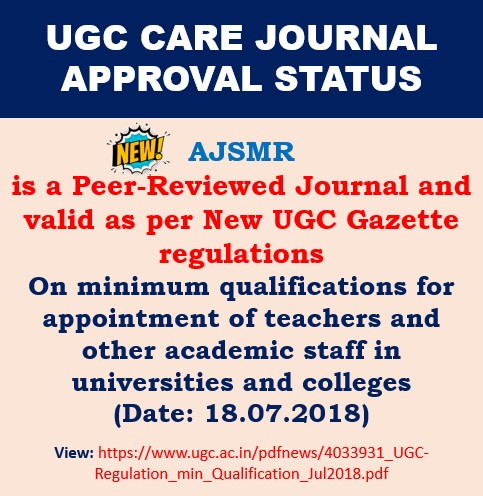Original Research Article I Volume 4 I Issue 3 I 2018
Effect of Ethanolic Extract of Physalis angulata on Dyslipidemia in Diabetic Rats
K. Krushnudu and Estari Mamidala
The American Journal of Science and Medical Research; 4(3); 20-23
DOI: http://dx.doi.org/10.17812/ajsmr435
Abstract:
Type 2 diabetes and dyslipidemia is a chronic medical condition that requires regular monitoring and treatment throughout life. In India, natural compounds from plant sources have been extensively used as traditional medicines from centuries. Physalis angulata plant composites have been widely used for the traditional treatment of diabetic mellitus, treatment of chronic diseases. Therefore, the objective of this present study is to evaluate ethanolic extract of P. angulata (EEP) on dyslipidemia in diabetic rats. The collected fruits were dried and powdered and extracted with using ethanol solvent by soxhlet apparatus. Hyperglycemia was induced in rats by using streptozotosin and treated with different concentration of ethanol extracts. Blood glucose levels and lipid profiles were measured after the treatment period. Oral administration of EEP (100, 200, 300 mg/kg) showed a significant reduction of blood glucose level as compared with diabetic control group. EEP (300 mg/kg) exhibited maximum hypoglycemic effect with reduction of glucose concentration from 289 to 203 mg/dl as compared to other doses of EEP. Treatment with EEP (100, 200 and 300 mg/kg) exhibited improved body weight as compared with diabetic control group. Maximum improvement (5.31%) was observed in EEP (300 mg/kg) dose as compared to lower two dosages. The treatment with EEP (200 and 300 mg/kg) showed significant reduction in cholesterol level (155.5±4.45 and 150.13±2.13 mg/dl) as compared with diabetic control group after 7 days of treatment. This study concludes that, the fruits extracts of the selected plant has antidiabetic effects and possess beneficial effect on the hyperglycemia associated with hyperlipidemia/dyslipidemia.
Keywords:
Physalis, dyslipidemia, antidiabetic, ethanol.
References:
[1]. Hyavarina, A., and Nikkita, E. (1962) Specific determination of blood glucose with orthotoluidine. Clin. Chim. Acta, 7, 140–143.
[2]. Chong, P. H., and Bachenheimer, B. S. (2000) Current, new and future treatments in dyslipidemia and atherosclerosis. Drugs, 60, 55–93.
[3]. Hultman, E. (1959). Rapid specific method for determination of aldosaccharides in body fluid. Nature, 183, 108–109.
[4]. Chatterjee DP, Sahu RK, Jha AK, Dwivedi J. (2010). Assessment of hepatoprotective activity of chloroform and ethanol extracts of whole plant of Cuscuta reflexa in CCl4 treated rats and effectiveness of extracts on lipoprotein secretion by hepatic cells. Pharmacologyonline. 3: 799-809.
[5]. Nimenibo-uadia R. (2003). Effect of aqueous extract of Canavaliaen siformis seeds on hyperlipidemic and hyperkotonaemia in alloxan-induced diabetic rats. Biokemistri, 15: 7-15.
[6]. Echeverri F, Arango V, Quinones W, Torres F, Escobar G, Rosero Y, Archbold R.(2001). Passifloricins, polyketides alpha-pyrones from Passiflora foetida resin. Phytochemistry. 56: 881-885.
[7]. Chiang HC, Jaw SM, Chen PM (1992). Inhibitory effects of physalin B and physalin F on various human leukemia cells in vitro. Anticancer Res 12, 1155–1162.
[8]. Magalhaes HI, Veras ML, Torres MR, et al. (2006). In-vitro and in-vivo antitumor activity of physalins B and D from Physalis angulata. J Pharm Pharmaco 58.
[9]. Samyal ML, Kumar H, Khokra SL, Parashar B, Sahu RK, Ahmed Z. (2011). Evaluation of antidiabetic and antihyperlipidemic effects of Artemisia dracunculus extracts in streptozotocininduced-diabetic rats. Pharmacologyonline.2011; 2: 1230-1237.
[10]. Magalhaes HI, Veras ML, Torres MR, (2006). Invitro and in-vivo antitumor activity of physalins B and D from Physalis angulata. J Pharm Pharmaco 58
[11]. Soares MB, Bellintani MC, Ribeiro IM, (2003). Inhibition of macrophage activation and lipopoly-saccaride-induced death by seco-steroids purified from Physalis angulata L. Eur. J. Pharmacol 459, 107–112.
Article Dates:
Received: 12 July 2018 ; Accepted: 19 August 2018 ; Published: 30 September 2018
How To Cite:
http://dx.doi.org/10.17812/ajsmr435 Received :12 July, 2018 Accepted; 19 August, 2018 Available online :30September, 2018



